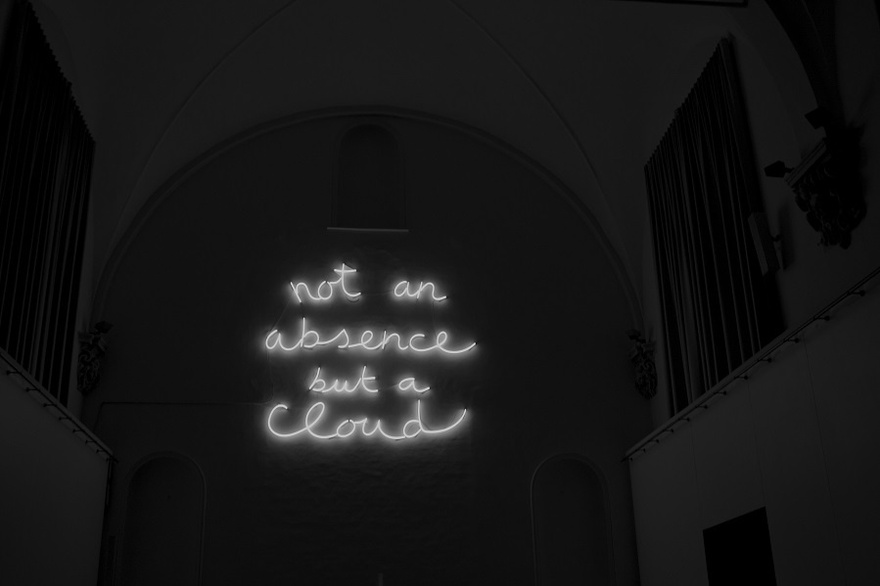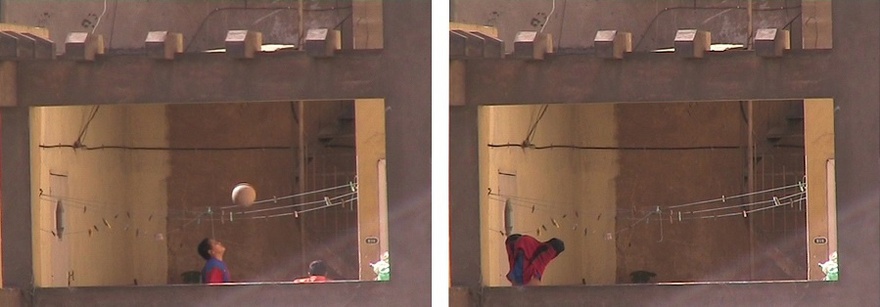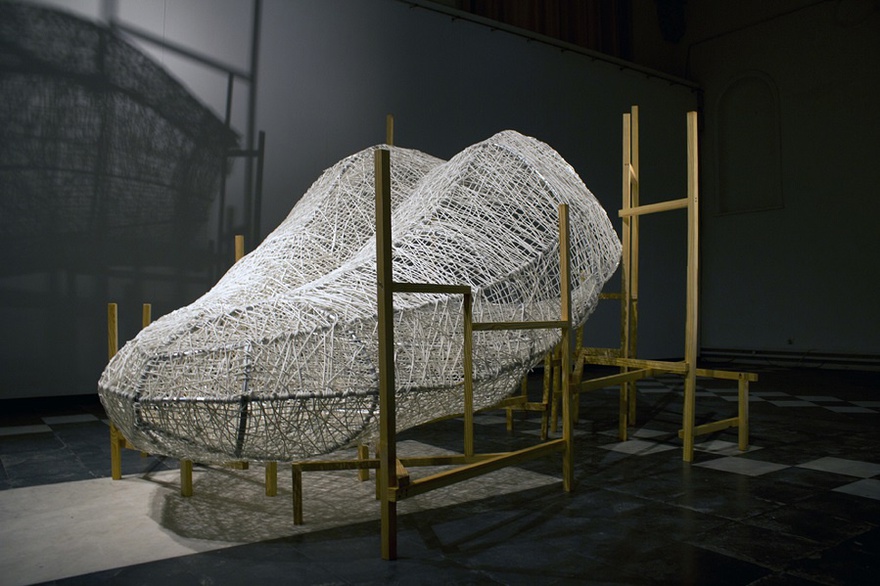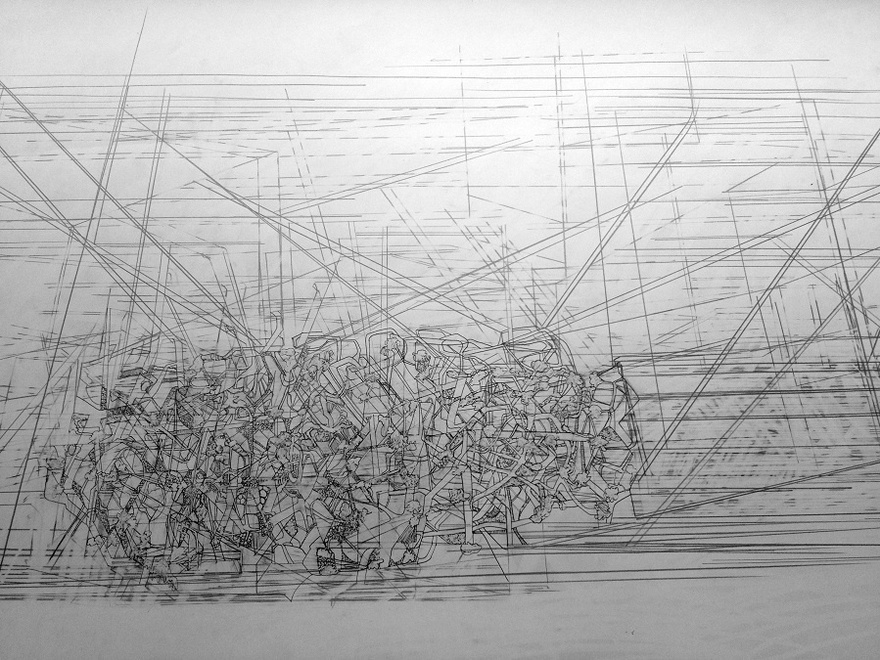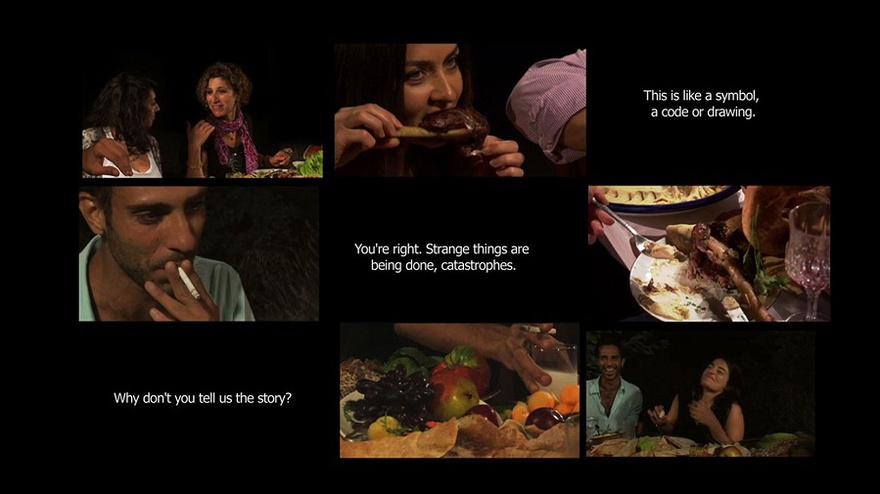Interviews
States of Suspension
Youmna Chlala in conversation with Fawz Kabra
Youmna Chlala is an artist and writer living and working in New York whose writing, poetry and art weave in and out of installation, video, sculpture, or performance works. Chance plays a key role in Chlala's practice, as she creates situations that are left to coincidence and happenstance, whether it is work that feeds on personal narratives or the artist's observations of a context from afar, an intervention in space, or a project that brings together actors to perform unscripted roles. In this interview, Chlala talks about her body of work, and particularly her recent project, Notes for Leaving and Arriving, produced for Ibraaz Platform 008 using Super 8 images and text. Chlala discusses states of suspension and the cyclical moments that occur from constant movement, and how light reveals the interstitial spaces between text and images that leave us suspended in various places.
Fawz Kabra: You are an artist who uses diverse media, from video, sculpture and installation to drawing. Can you tell me how you see your writing and art coming together through this diversity?
Youmna Chlala: I'm interested in the way certain questions can only be answered through specific forms. Lately, I've been working on drawings that are spatial investigations about making room or making way. For this series, which is called How to Host a Body or a Place (2014), I wanted to figure out these questions through the hand. I also like using elemental materials, like paper, ink, lead, and eraser, which allow for chance discoveries. Sometimes it's only through scale that perception changes. This happened when I was working on the sculpture Langue (2013) as part of a larger project I Am Who You Say I Say Who You Are (2013), about hysteria as a form of translation. The materials were also basic: wood, aluminum and rope. It became like a drawing in space. I wanted to magnify the tongue as an object that had a surreal presence, but because of the materials and scale it also could be perceived as not quite there. It became a form outside the body to be encountered, and this tongue was to remain under continuous construction.
FK: Can you tell me about the project for Ibraaz titled Notes on Arriving and Leaving? How did you begin? Did you start somewhere and end in another place?
YC: I see the process of making this project very much aligned with its many incarnations and it's really a Part 1 of a longer series of works. I filmed all of the images as a way to notate where I was at the time – more emotionally than physically. It was 2009, I was moving cities and the last thing I did before leaving was get a Super 8 camera from a film student who was selling it for really cheap because he himself was about to leave. I liked that this object was being transferred at this moment of change for both of us. I carried it around for a long time before deciding to film. Having it with me while I travelled created quite a few comedic moments at airports where it was often dissected as a potential threat!
When I began filming I was trying to articulate the feeling of being between places. Then just this year, when Ibraaz approached me with questions about multiple centres and the role of peripheries, I was reading a lot of texts about sight and seeing such as Luce Irigiray's essay 'Being Two, How Many Eyes Have We?' where she suggests that we begin to activate certain objects through the language of the senses. What if we understood the tree as treeing or the sky as skying? Suddenly these images and texts that I had been accumulating took shape. They became a series about continuous and simultaneous states of being, of leaving and arriving.
FK: I see the Super 8 frames as fragments of a moment, fleeting images of an unidentifiable place, slipping away. Can you tell me more about these moments?
YC: The moments are related to a multiple sense of place. By taking the moving image and making it into a still, I could play with time and sequence so that the moment becomes like a dream or a reoccurring memory. I think that slippage assumes a falling away or loss. I'd rather that these moments reflect diffusion – the way that light as material both disperses and clarifies an image. These moments aren't lost, instead they are scattered and rearranging them creates movement or reinvention.
FK: Tell me more about how you view light as a material here.
YC: I like the way that light can sometimes harden into a shape or become a force in an image, how it has a kind of temperature that marks the moment. Illumination is about clarity or sight and for this project, that's about what we choose to see. Light is a central part of the image with as much meaning and value as other signifiers like a building, an object or a body.
FK: The Super 8 medium drops the piece into a time period of such cameras and family films in the 70s. Is there something about this time in particular that are you working with here?
YC: These images are not future bright, rather they reveal a dream-like state. They are not trying to access a specific moment in time, instead they appear and disappear and you can't tell if they are about presence or absence. This isn't necessarily nostalgic it's more about a re-inscription, the way we come to know something by experiencing it over and over again. These are places that I've been to or lived in many times yet each time I'm not certain if I will return. I used to think this was about instability and Beirut in particular but over time I've come to realize that it's actually a way of trying not to have an attachment to place.
FK: The corner light leak, the film burn, means that you are working with the edge of the film reel. How do you use these forms?
YC: These fissures, erasures, accidents, and chance moments are based on the materiality of film. In drawing, this happens through erasure and the reinvestigation of the line. The beauty of working with film is its scarcity. These were three-minute reels so the fleeting quality is embedded. It made me especially aware of the edges like in the beginning when I adjust the lens or towards the end when the film eclipses into unpredictable colours and forms. This became a way to express the arrival into a new space, at the moment when the image is at its most uncontrolled, when it is both bright and burnt.
FK: The images are broken up by text or the text is broken up by images. Where is the text drawing from and what is the kind of language that you are referencing?
YC: I was really interested in creating a language that took shape like the images, through happenstance and outside of the original intention. So the text is fictional and not found text. The use of the second person imposes the narrative on the viewer. This is also meant to extend the idea of exchange into one where the boundaries of who 'owns' the language or 'is having the experience' keep changing.
FK: It is interesting to hear you say that the text is fictional. That is not immediately recognizable and I wonder if it is important for a reader to know that it is fictional. The fracture here is between what happens in the image and what is imagined through the text, but also the tension between a so-called reality within the image and the fiction of the text. These two worlds gently bump into one another.
YC: And it is exactly at this bump or fricative point that premonition takes place.
Henri Lefebvre, when addressing the production of space, wrote about the fallacy of the way that people look, and take sight, take seeing, for life itself. When we recognize or find associations with what is visible, we are reassured that we can believe it. I want to complicate this notion by placing the viewer in an interpretative position. So I conflate real and invented space and narrative. You are then forced to intuit the meaning, to remain uncertain and it is in this unreliable state that premonition takes over and you begin to visualize what's possible rather than what is in the past or present.
FK: Can you tell me about the role that 'exile' has in the shaping of this piece and particularly your relationship to that term or idea?
YC: The term immediately imposes distance. Sometimes, this brings clarity or new perspective, though most of the time it's about loss and longing. This narrator undergoes constant geo-political and personal shifts. I didn't want to separate what happens in the realm of politics or war or violence from what occurs in the body or through relationships. This means that it is also inhabited and internal. I want it to be so dizzying that the viewer can no longer tell where the exile begins or ends. These sets of images are both private and public spaces. And the text names this distancing as self-imposed, nostalgic, frozen in time, while it can also reveal that maybe you don't belong where you think you should be or where you want to go back.
FK: Is there a place of departure and a place of arrival?
YC: I see the points of departure and arrival as flux. Each one occurs rhizomatically. Since the project is a kind of city-based way of mapping, the story begins in Beirut and I'm not sure if it will cycle back there or keep expanding. I've learned that no matter what happens, for me, everything leads back to Beirut! There's a beautiful book by Mai Ghoussoub titled Leaving Beirut (2007) and I have reread it frequently not necessarily because of the stories, but more as a way to keep her alive and to see how I've changed since the last time I read it and since my last leaving.
FK: Sometimes the aesthetic of a blurred or grainy image alludes to memory. Can you describe your process and thinking behind the making of (these) images that can bring someone back or propel them forward?
YC: The blur, grain, and the fragment engage the vacillating states of being, the way memory is being invented and re-imagined just as much as the future.
FK: The text does not reveal a particular place and neither do the details in the photographs. But the glimpses of land, buildings, and sea tell us that we are suspended in these various spaces. How do you see this tension of specific place and ambiguity playing out in the piece?
YC: I love that you got a sense of the suspension. This is a state of being that I wanted to embody in this project, especially the way that spaces that seem localized or rooted are actually experienced as in-between. The notion of fate or the inevitable creates a kind comfort that can be complicated and dangerous, it can stop us from ever leaving. Or the perpetual reliance on arrival as a space of possibility can create a constant dislocation. These ideas are explored by making moving images into still frames. And in the narrative, I'm interested in how this kind of suspension affects the people who move through these spaces.
FK: Does this work relate to other projects you have done? I can't help but think of works such as Days of Being Wild (2013) where you document two boys playing football within a walled balcony. In both this piece and Days of Being Wild, there is a sense of looking in to another world. But you also have Trespass the Salt (2012), a video collaboration with Larissa Sansour where the entire setting is also a fiction, different places happen at once, the participants are in a non-distinct setting with two performances (filmed separately) happening in the same place at once. I find a kind of suspension reoccurring in each work. Could you tell me more about this?
YC: I definitely find myself in a constant inquiry of suspended states. For Trespass the Salt, our choice of video as third/virtual space and editing method as translation/cutting-up the conversation and reinventing the script then orchestrating a false gathering as a singular moment in the same place, allowed us to create this unrealized or potential space. The suspension provides possibilities that would otherwise not exist given the current geo-political situation in Lebanon and Palestine. For Days of Being Wild, suspension functions as both a voyeuristic act and a space that battles didactic imagery and narrative. It is Cairo, but Cairo is silent. It is a game on a private balcony, but there is no beginning or end, no side to choose, no perceivable public body to examine.
FK: Can you tell me about your writing and the use of text in your work?
YC: This varies quite a lot. For example, I might use text for the light sculpture Somewhere Between Suspended and Ecstatic (2013), a work that plays with the notion of a cloud as an object and relates to hysteria in the way that language can be reclaimed. The story behind it is that of Anna O. who when diagnosed with lapses in consciousness refuted Freud by describing these 'lapses' using an English word: 'cloud'. The work was then installed in a chapel in Bruges in the space where there would have been a religious icon. For this sculpture, language was a catalyst for thinking about translation and the body and our contemporary associations with the cloud.
In other projects, text and writing remain on the page. This happens in the artist book, Grand Amour (2010), which is composed of found text about Beirut around 1982 and love letters that I write and never send to Carolee Schneemann about my encounters many years later with her War Mop (1983) installation and booklet.
On a conceptual level, I see the role of fiction as a space without gravity. Of course there are confines such as rules, craft, style and so on, but the possibilities for inventing a world exist through language. At the same time I like the tension with the real, the limitations of language, the mishaps of translation, the cacophony of thinking in multiple languages and the subversion of form, style and genres. These are the spaces where the text and visual align and begin to redefine each other.

